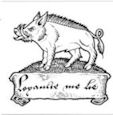The Wait is over!
 The Times informed us today that the real location of the Battle of Bosworth has finally been uncovered. Today it was revealed that the battle took place “round the back of Alf Oliver’s arable farm, just off the old Roman road from Atherstone to Leicester in a field as featureless as any in England”. The newly identified site is approx. 2 miles from the Bosworth visitor centre on Ambion Hill. To get there you drive south and west from the visitor centre, passing a farm enterprisingly selling “battlefield beef”.
The Times informed us today that the real location of the Battle of Bosworth has finally been uncovered. Today it was revealed that the battle took place “round the back of Alf Oliver’s arable farm, just off the old Roman road from Atherstone to Leicester in a field as featureless as any in England”. The newly identified site is approx. 2 miles from the Bosworth visitor centre on Ambion Hill. To get there you drive south and west from the visitor centre, passing a farm enterprisingly selling “battlefield beef”.
Glenn Foard, the archaeologist who headed the team searching for the true battlefield site, explained: “My best guess is that Richard’s last charge came down the Roman road there”, pointing to where occasional cars passed one side of the field. “He is then driven back into the mire and killed somewhere near here.”
Mr Foard also showed a gilt solid silver boar, which was found by Carl Dawson, a retired university lecturer with a metal detector. Only 1½in (38mm), it is a thing of beauty: a snarling beast rippling with muscle definition and with gilded highlights on its tusks, tail and bristles. As we know, the boar was the emblem of Richard III. Only one similar one is known, in the British Museum. He went on to point out: “If we were looking for any artefact at all and if there’s any location we might want to find that artefact, then it’s the white boar badge of Richard III next to the marsh. This is almost certainly from a knight in Richard’s retinue, who rode with him to his death on that last charge.”
Following the article are several comments on it. Two are particularly poignant pointing out how different history would have unfolded had Richard III won the day instead of the usurper Henry Tudor.
So now we know where “on this day [22 August 1485] was our good king Richard piteously slain and murdered to the great heaviness of the city [of York]”.
Loyaulte me Lie.
Note: read the full article from The Times as well as the comments here. You can watch a video of the site on the BBC website, which also includes a picture of the found boar badge and a map showing the new location. Thank you to our friends from the American branch for bringing this to our attention.
Tags: Bosworth, Henry Tudor, Richard III

 We shall be remembering Richard’s cruel death at the
We shall be remembering Richard’s cruel death at the 